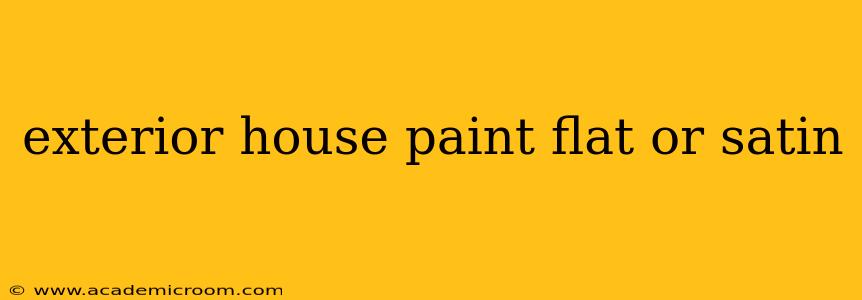Choosing the right exterior paint finish is crucial for protecting your home's exterior and enhancing its curb appeal. Two popular choices are flat and satin, each with its own set of advantages and disadvantages. This comprehensive guide will help you understand the differences between flat and satin exterior house paint, enabling you to make an informed decision for your home.
What is Flat Exterior Paint?
Flat exterior paint, also known as matte paint, has a non-reflective, low-luster finish. This means it minimizes the appearance of imperfections on the surface of your home's siding. It provides a classic, sophisticated look, often favored for its ability to subtly blend into the environment.
Advantages of Flat Exterior Paint:
- Hides Imperfections: The non-reflective nature of flat paint effectively masks minor blemishes and imperfections in the siding.
- Elegant Appearance: It creates a sophisticated, understated aesthetic that appeals to many homeowners.
- Good for Certain Styles of Homes: Flat paint pairs well with traditional or rustic architectural styles.
Disadvantages of Flat Exterior Paint:
- Difficult to Clean: Because it's porous, flat paint is more challenging to clean and maintain. Dirt and grime tend to adhere more easily, requiring more frequent washing.
- Less Durable: Compared to satin or semi-gloss, flat paint is less durable and susceptible to damage from weather and abrasion.
- Not Ideal for High-Traffic Areas: Areas prone to scuffs or scratches, such as doorways or trim, are better suited for a more durable finish.
What is Satin Exterior Paint?
Satin exterior paint offers a subtle sheen with a smooth, slightly reflective finish. It strikes a balance between the low-luster appearance of flat paint and the high gloss of semi-gloss or gloss paints.
Advantages of Satin Exterior Paint:
- Easy to Clean: The slightly reflective surface makes it easier to clean dirt and grime. A simple hose-down often suffices.
- More Durable: Satin paint offers better protection against weather, mildew, and abrasion than flat paint, extending its lifespan.
- Moisture Resistant: Its less porous nature provides better resistance to moisture penetration, crucial for protecting your home's exterior.
- Versatile: Satin paint complements a wide range of architectural styles and colors.
Disadvantages of Satin Exterior Paint:
- Shows Imperfections More Easily: The subtle sheen can highlight minor imperfections in the siding more than flat paint.
- Less Dramatic Look: Some homeowners may prefer the more dramatic, subtle look of flat paint.
Which is Better: Flat or Satin Exterior Paint?
The "better" choice depends entirely on your priorities and the specific needs of your home. Consider these factors:
- Your Home's Style: Flat paint works well with traditional homes, while satin is more versatile.
- Your Climate: In areas with harsh weather conditions, satin's durability is advantageous.
- Your Maintenance Preferences: If you prefer low-maintenance, satin is the better option.
- Your Budget: While the initial cost may be similar, the longer lifespan of satin paint can lead to cost savings in the long run due to reduced repainting needs.
How Often Should I Repaint My House Exterior?
The frequency of repainting depends on several factors, including the quality of the paint, weather conditions, and the presence of mildew or other damage. Generally, however, exterior house paint should last 5-10 years. Regular cleaning and maintenance can extend this lifespan significantly.
What Kind of Paint Should I Use for My Exterior Trim?
Exterior trim often benefits from a more durable finish than the main body of the house. Semi-gloss or even gloss paint is commonly used for trim due to its superior cleaning and abrasion resistance. This protects the trim from scuffs and damage.
Can I Use Interior Paint on the Exterior of My House?
No, you should never use interior paint on the exterior of your house. Interior paints are not formulated to withstand the elements and will quickly deteriorate, leaving your home vulnerable to damage. Exterior paints are specifically designed to resist weather, UV rays, and moisture.
What is the Best Paint for a Hot Climate?
In hot climates, choosing a paint with excellent heat reflection properties is essential. Many manufacturers offer paints specifically formulated for hot climates, often incorporating features that enhance reflectivity and reduce heat absorption. Consult a paint professional for recommendations based on your specific region.
By carefully considering these factors and weighing the pros and cons of flat versus satin exterior paint, you can choose the best finish to protect and beautify your home for years to come. Remember to always prepare the surface properly before painting for optimal results.
